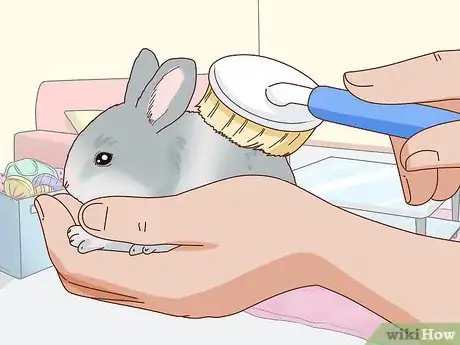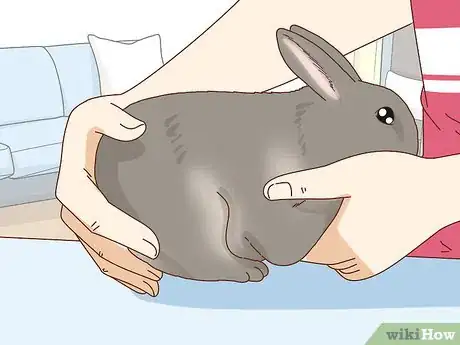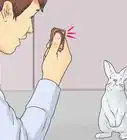This article was co-authored by Pippa Elliott, MRCVS and by wikiHow staff writer, Megaera Lorenz, PhD. Dr. Elliott, BVMS, MRCVS is a veterinarian with over 30 years of experience in veterinary surgery and companion animal practice. She graduated from the University of Glasgow in 1987 with a degree in veterinary medicine and surgery. She has worked at the same animal clinic in her hometown for over 20 years.
wikiHow marks an article as reader-approved once it receives enough positive feedback. In this case, 88% of readers who voted found the article helpful, earning it our reader-approved status.
This article has been viewed 99,773 times.
Rabbits are soft and cute, but their natural shyness means that they're not always the cuddly companions you may be hoping for. If your rabbit is scared or shy, you'll need to put in some time and effort to gain its trust. Offer your timid bunny a safe and quiet environment and give it some time to get used to your presence. Once your rabbit comes to associate you with comfort and security, you can begin to form a true friendship with your pet.
Steps
Creating a Comforting Environment for the Rabbit
-
1Choose a cage or hutch that your rabbit can enter or leave at will. This doesn't mean that you have to leave the hutch open all the time. However, when the hutch is open, the rabbit should be able to go in and out without you having to pick it up.[1]
- Look for a hutch with a door in front instead of (or in addition to) a hinged or removable top. This will allow your rabbit to hop in and out comfortably without your assistance.
-
2Get a hutch with enough space for your rabbit to move and stretch. If your rabbit lives in cramped conditions, it will feel stressed and trapped. Select a hutch where your rabbit can stretch out in all directions and stand up on its hind legs without its ears touching the top.[2]
- At minimum, your rabbit should be able to take 3 hops from one end of the enclosure to the other.
- Ideally, the hutch should be either permanently attached to a larger exercise run or placed in a room where the rabbit can go out and explore safely at any time.
Advertisement -
3Give your rabbit a hiding place in the hutch. This could be something as simple as a cardboard box or a paper bag that your rabbit can retreat into. If your rabbit has no place to hide out when it's feeling scared, tired, or insecure, it will begin to feel stressed out and frightened all the time.[3]
- If you have more than one rabbit, you should have at least one hiding place per rabbit.
-
4Keep your rabbit in a quiet area. Your rabbit will feel safest in an area that is quiet, well-ventilated, and neither too hot nor too cold. Keep your rabbit in a place where it will not be disturbed by other pets, loud noises, or lots of foot traffic.[4]
- Your rabbit should be able to eat, drink, sleep, play, and explore without feeling like it is in danger from potential predators.
- Ideally, at least one side of the hutch or cage should face a wall. That way, your rabbit won't feel like it always has to watch its back.
Getting Your Rabbit Used to You
-
1Give your new rabbit a couple days to adjust on its own. If you just got the rabbit, give it some time alone in its new environment. Let the rabbit explore and get to know its new surroundings for 1 or 2 days without the pressure of having strange people in the room.
- When you need to come into the room to feed your rabbit or change its water, make sure to approach slowly and quietly. Don't try to touch or hold your rabbit yet, and keep your interactions brief.
-
2Start spending time in the room with your rabbit. Once your rabbit has had some time to adjust, spend a little time just hanging out near the cage or hutch. Don't bring other pets or people into the room, and keep the environment quiet. Sit or lie down on the floor near the hutch so that you don't intimidate the rabbit by towering over it.[5]
- If you like, you can try talking to the rabbit in a calm, gentle voice.
- Spend at least a little time hanging out with your rabbit each day so that your presence becomes part of its routine.
-
3Let the rabbit out of its hutch if it seems calm in your presence. If your rabbit seems fairly relaxed while you're in the room, try letting it out to explore. Open the door to the cage or hutch, but don't try to touch or grab the rabbit. Sit or lie quietly nearby and wait for the rabbit to come out on its own.[6]
- Your rabbit may not feel confident enough to come out at first, and that's okay. Just continue hanging out by the cage and quietly talking to your rabbit for a little while each day until the rabbit is ready to come out.
- If the rabbit does come out, don't approach it or try to touch it. Let the rabbit come to you. After enough time, it may sniff you or even climb up on you.
- Once the rabbit begins to explore, it may take some time (possibly an hour or more) for it to approach you, so be patient.
-
4Allow the rabbit to nibble some treats from your hand. When you spend time with your rabbit, bring a small piece of apple or banana or a pinch of oats. Hold the treats in your open hand and let the rabbit sniff them out. Keep the treats in your hand while the rabbit eats them.[7]
- Offering treats in a non-threatening way will help your rabbit learn to associate you with positive things.
-
5Try petting the rabbit once it's comfortable near you. Give your rabbit time to get used to being around you. Once the rabbit is confident enough to approach you routinely and eat treats from your hand, try offering it a gentle scratch on the forehead. From there, you may be able to move on to stroking the rabbit's back or even touching noses with it.[8]
- If your rabbit shies away from your touch, don't press the issue. Give your rabbit another day or 2 to get used to you before you try again.
Handling Your Rabbit Correctly
-
1Start handling your rabbit as early as possible. Rabbits that are socialized and handled from a young age have an easier time getting used to being touched and held. If possible, work on making handling a positive, non-threatening experience for your rabbit while it is still a baby or juvenile.[9]
- If your rabbit has grown up without human contact or has ever been handled roughly by a human, it may find it very difficult to adjust to being touched. In cases like this, it may take extra time and effort to build the rabbit's trust, and it may never feel completely comfortable being touched.
-
2Move slowly and quietly when approaching and handling your rabbit. Take care not to startle your rabbit with loud noises or sudden movements. Rabbits are prey animals, so their instincts tell them to be constantly on the alert. If you startle your rabbit, it may feel like it is under attack.[10]
- Talk to your rabbit in a quiet, soothing voice and stay in its line of sight when you approach. If you sneak up on your rabbit and touch or grab it from behind, it will become frightened.
-
3Avoid picking up your rabbit unless you have to. Most rabbits don't like to be picked up or carried, and this is especially true of shy or skittish bunnies. Don't pick up your rabbit unless it's necessary (e.g., if you need to groom the rabbit or take it to the vet).
- Even if your rabbit hates being picked up, it may still voluntarily climb up in your lap or snuggle up against you if it feels comfortable enough with you.
-
4Pick up your rabbit from as close to the ground as possible. Rabbits don't like heights, so avoid carrying your rabbit high above the ground if you can.[11] For example, if you need to pick up your rabbit to put it in a carrier, try setting the carrier on the ground next to the rabbit's cage or hutch and kneeling while you move the rabbit into the carrier.
- In addition to helping your rabbit feel more secure, staying close to the ground is safer for your rabbit. If your rabbit is up high, it is more likely to panic and struggle, possibly resulting in accidental falls.
-
5Support your rabbit's feet if you have to pick it up. If you must pick up your rabbit, make sure it feels secure by keeping a hand under its hindquarters at all times. It will also feel safer if you hold all 4 of its legs gently but firmly against your body.[12]
- Your rabbit may also feel more secure if you tuck its head gently under your arm or a towel.
-
6Use minimal restraint while holding the rabbit. You should hold your rabbit firmly enough so that it feels supported, but not tightly enough to cause any pain or make it feel trapped. Always handle your rabbit gently, and only use as much force as you need to in order to hold on to the rabbit securely.[13]
- Never pick up your rabbit by its ears! This is traumatic for the rabbit and could cause serious injury.
Warnings
References
- ↑ http://www.bio.miami.edu/hare/shybun.html
- ↑ https://www.nidirect.gov.uk/articles/suitable-environment-rabbits
- ↑ https://www.nidirect.gov.uk/articles/suitable-environment-rabbits
- ↑ https://www.nidirect.gov.uk/articles/suitable-environment-rabbits
- ↑ http://www.bio.miami.edu/hare/shybun.html
- ↑ http://www.bio.miami.edu/hare/shybun.html
- ↑ http://www.bio.miami.edu/hare/shybun.html
- ↑ http://www.bio.miami.edu/hare/shybun.html
- ↑ https://www.rspca.org.uk/adviceandwelfare/pets/rabbits/company/handling
- ↑ https://www.rspca.org.uk/adviceandwelfare/pets/rabbits/company/handling
- ↑ https://www.rspca.org.uk/adviceandwelfare/pets/rabbits/company/handling
- ↑ https://www.rspca.org.uk/adviceandwelfare/pets/rabbits/company/handling
- ↑ https://www.rspca.org.uk/adviceandwelfare/pets/rabbits/company/handling
- ↑ https://www.rspca.org.uk/adviceandwelfare/pets/rabbits/company/handling
- ↑ http://www.bio.miami.edu/hare/shybun.html
- ↑ https://www.rspca.org.uk/adviceandwelfare/pets/rabbits/company/handling
About This Article
Before you try to befriend a shy rabbit, give it a couple of days to adjust to its new home. Then, once your rabbit has calmed down a little bit, start spending time near its enclosure so it can get used to your voice and scent. If it seems relaxed in its cage when you're around, try letting it out and feeding it some treats. Eventually, when your rabbit is confident enough to eat treats from your hand, you can start petting it and holding it in your arms. For more tips from our Veterinary co-author, like how to safely hold a rabbit, scroll down!





































































